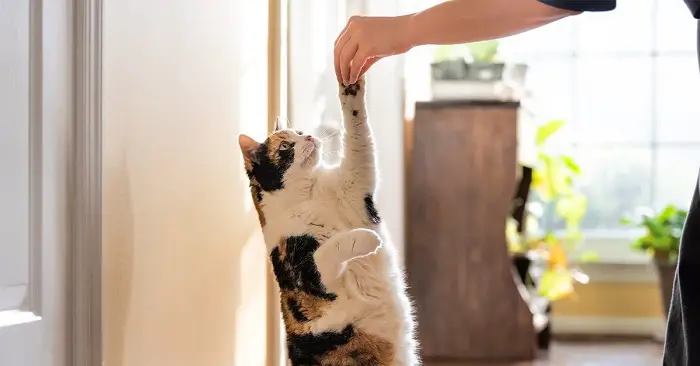Cat behavior encompasses a wide range of actions and reactions domestic cats exhibit. Innate instincts, learned behaviors, and individual personality influence it. Cat behavior can be complex and fascinating. Understanding your cat’s behavior can help you build a better relationship with your feline friend.
Most Common Cat Behavior Facts
The most common and essential cat behavior facts are:
- Purring: Cats often purr when they’re content, but they can also purr when they’re in pain or anxious. It’s a versatile form of communication.
- Kneading: Cats knead with their paws, which signifies comfort and contentment. It’s a carryover from kittenhood when they kneaded their mother’s belly to stimulate milk flow.
- Scratching: Cats scratch to mark territory, sharpen their claws, and stretch. Providing appropriate scratching posts can help prevent destructive scratching.
- Grooming: Cats are meticulous groomers, which helps them stay clean and serves as a self-soothing behavior. They groom themselves and other cats to strengthen social bonds.
- Play Behavior: Cats are playful animals; play is crucial for their physical and mental well-being. Toys and interactive playtime can keep them active and engaged.
- Hunting Behavior: Cats have a strong instinct to hunt and may “hunt” toys or imaginary prey. This behavior is a way to practice their hunting skills.
- Greeting Behavior: Cats may show affection by head-butting, purring, or rubbing against their owners. These are signs of trust and friendship.
- Hiding: Cats often hide when they feel unwell, anxious, or want a quiet, safe space. Providing a comfortable hiding spot is essential.
- Sleeping: Cats are known for sleeping a lot, and it’s perfectly normal. They are crepuscular, meaning they’re most active during dawn and dusk.
- Litter Box Behavior: Cats are usually very clean animals. If they start urinating or defecating outside the litter box, it could indicate a health issue or a problem with the litter box.
- Body Language: Cats communicate a lot via their body language. A puffed-up tail might signal fear or aggression, while a relaxed body posture indicates contentment.
- Territorial Behavior: Cats are territorial and may mark their space by rubbing their scent on objects and scratching. They often establish territories within their homes.
- Scent-Marking: Cats have scent glands in various parts of their bodies, and they use scent marking to communicate with other cats and demonstrate their presence.
- Social Behavior: While some cats are more independent, many enjoy social interaction and may groom, play, or cuddle with their owners and other cats.
- Aggression: Cats can display aggression for various reasons, including fear, territorial disputes, or medical issues. Identifying the cause of aggression is essential for addressing it properly.
Final Talk on Cat Behaviors
Understanding these aspects of cat behavior can help you provide the best care, enrichment, and companionship for your feline friend. Remember that each cat is an individual, and patience, observation, and responsiveness are crucial to nurturing a positive and harmonious relationship with your cat.
